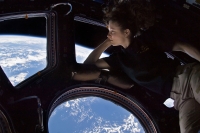BRILLIANT WOMEN IN ASTRONOMY
 Share on Facebook
Share on Facebook
 Astronomy is an unusual science, for centuries it has appealed to, and been advanced by women as well as men, often despite the peculiar social attitudes prevalent in much of history. This is a great, great blessing because it effectively doubles the amount of talent available.
Astronomy is an unusual science, for centuries it has appealed to, and been advanced by women as well as men, often despite the peculiar social attitudes prevalent in much of history. This is a great, great blessing because it effectively doubles the amount of talent available.
A few years ago I wrote about how many prominent women there have been in the history of astronomy, from Hypatia in ancient Alexandria to Jocelyn Bell and her discovery of pulsars in the 1960s. Incidentally, a pulsar emits a rapid beeping radio signal which for a short time made people wonder if it was from aliens, so it got nicknamed LGM 1, short for little green men.
It’s time I brought all this up to date. Astronomy is still attracting a lot of very clever women, from our little group, which is nearly an equal mix of the sexes, to all the different specialist branches of astronomy, and to astronauts.
Katherine Johnson is a name you might know, she was featured in the film Hidden Figures, about the early days of NASA, and she was a human computer, who did the calculations to launch the first spacecraft and have a safe re-entry.
Do you remember the name Helen Sharman? She was Britain’s first person into space. Carolyn Porco is sometimes called the rock star of space science, she has worked since the 1980s interpreting the results from spacecraft visiting the outer planets. When you see an amazing picture of Pluto taken from space, that’s probably her work. When asked where she spent most of her time working she once replied ‘amongst the rings of Saturn’.
Almost everyone has heard of dark matter, probably the biggest puzzle in modern cosmology, the ‘most of the universe is missing’ puzzle. Did you know it was a lady who first discovered it? Vera Rubin is her name, and she penned the galaxy rotation problem. She was also the first women to have a large observatory named after her, the Rubin observatory in Chile. There’s also a group of women hardly anyone has heard of, the Mercury 13. They were a group of accomplished women pilots who were given the same tests as the men to be astronauts, it was only a presidential decision in 1960 that dashed their hopes.
I could go on and on with a seemingly endless list of past and current people, there are so many in planetary science, solar physics cosmology etc. Compare astronomy with the medical profession, women make great doctors, but it was nearly impossible for them until modern times, and not long ago some people hated the idea of female aircraft pilots. I wonder what they would think of the many female astronauts. If you like a bit of hard science, this bit would have upset some blokes in the past. Women’s physiology is better suited to space travel than men’s. It’s all to do with hydration levels and oxygen consumption against energy expenditure. This has been known for a long time, but the engineering challenges in making decent personal plumbing equipment for zero gravity were very hard. Maybe in the future I’ll write about the evolution of the space toilet!
I’ll finish this month with a stunning picture of astronaut Stacy Caldwell Dyson in the cupola of the International space station. She’s got the best view in the world, and off it.
Charles Oates, Vega Baja Astronomy Group.
● To find out more about observing and astronomy why not join our group, email us at This email address is being protected from spambots. You need JavaScript enabled to view it. to find out more.
